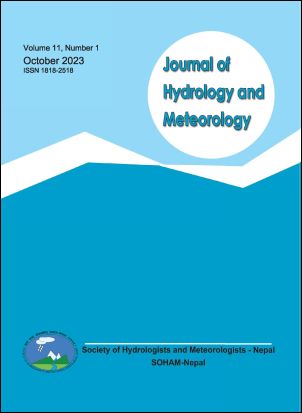Urban Heat Variation and Temperature Lapse Rate in the Kathmandu Valley
DOI:
https://doi.org/10.3126/jhm.v11i1.59664Keywords:
Urban Heat, Temperature lapse rate, Inversion, Kathmandu Valley, NepalAbstract
The rate of urbanization growth has accelerated and made urban areas comparatively warmer than surroundings which are the main issues of urban heat worldwide. The Kathmandu Valley is one of the million plus cities with the fastest rate of urbanization and consequent extreme heat. In this study, urban heat was analyzed using both in-situ and satellite-based observation and estimated temperature lapse rate. The Mann Kendell test, Sen’s slope, raster image analysis and lapse rate estimation methods were used. The results showed that average temperature difference in between urban core and surrounding was 4.07°C from 1990 to 2020. Likewise, the summer day temperature in Putalisadak was 8.8°C higher than the Nagarkot. The maximum temperature has increased in all stations where Godavari station has increased significantly (0.073°Cyr−1, p<0.0001). During all seasons, the daytime temperature is higher than the nighttime temperature. The maximum 32.86°C daytime temperature was recorded on August 4, 1pm and the minimum temperature was 3.67°C on Jan 20, 6am, 2020 at the city core. Similarly, the highest temperature was recorded at 31°C in Bagbazar and 33°C in Patan on July 10 and July 11, 2022 respectively when the humidity was lower. Satellite-based observation also shows that the urban heat scenario of the Kathmandu Valley was higher in the urban core which was ranges from 21.06 to 26.09 during 2000-2020. The temperature of the city has increased. However, temperature lapse rate in response to Nagarkot (reference station) is normal i.e decreased temperature in response to increased height. The higher lapse rate is generally found in the Godavari and lower was observed in the Machhegaoun. Overall, the Kathmandu Valley is getting more warmer compared to the surroundings. This comprehensive study is useful to explore the understanding of urban heat islands and temperature lapse rate in the major cities in compared to the surroundings in Nepal.




